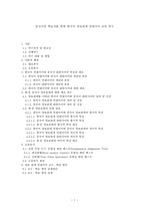

-
 * 본 문서는 배포용으로 복사 및 편집이 불가합니다.
* 본 문서는 배포용으로 복사 및 편집이 불가합니다.
미리보기
서지정보
· 발행기관 : 한국융합인문학회
· 수록지 정보 : 한국융합인문학 / 4권 / 3호
· 저자명 : 뤼창화
목차
Ⅰ. 서 론
1. 연구의 목적 및 필요성
2. 선행연구 검토
3. 연구의 방법
Ⅱ. 한국어 양보관계 연결어미의 통사적 특징
1. 주어 제약
2. 선행 요소
3. 선어말어미 제약
4. 후행절 서법 제약
5. 호응부사 제약
Ⅲ. 결 론
참고문헌초록
한국어 접속문에서 두 절을 연결시켜 주는 중요한 요소는 연결어미이며, 연결어미를 통해서 두 절의 상 호관계가 드러난다. 반면에 중국어의 접속문은 주로 관련 사어를 이용하여 두 절을 연결한다. 중국어의 관련 사어는 연사와 관련부사의 결합형식으로 한국어의 연결어미와 같은 기능을 담당한다. 이러한 언어 적 특성의 차이로 인해 중국인 학습자가 한국어를 배울 때에 연결어미를 학습하는 것은 특히 어렵고, 많은 오류가 발생하게 된다. 양보 연결어미의 사용 빈도가 비교적 높고 각 항목은 특징에 있어 차이가 존 재한다. 그렇기 때문에 학습자들이 각 항목의 통사적 특징을 모두 파악하여 습득하는 것은 쉽지 않다. 그래서 본 논문의 목적은 중국어권 학습자 위한 한국어 양보관계 연결어미 ‘-아/어도’, ‘-더라도’, ‘-ㄹ 지라도’, ‘-ㄹ망정’, ‘-ㄹ지언정’, ‘-ㄴ들’을 중심으로 통사적 특징을 살펴본다. 본 논문의 목표는 한국어 양보관계 연결어미의 통사적 특징을 정확히 파악하게 할 수 있고, 문법 요소 사용 능력을 향상시킬 수 있다는 점에서 의미가 있다.영어초록
Korean language is an agglutinative language, while Chinese language is an isolated language. On this account, learners whose native language is Chinese have difficulty in learning Korean. Concessive conjunctive endings in Korean are an important factor in connecting two clauses. Because of characteristics of the Korean language, it is especially difficult for Chinese learners of Korean and they make a lot of errors. Based on the above content, the purpose of this study is to help Chinese learners of Korean use correctly concessive conjunctive endings in the Korean language. Because of the syntactical characteristics of concessive conjunctive endings, they are difficult to understand. This study is just to research the effective validity of the concessive conjunctive endings of high usage frequency and error frequency for Chinese educators of Korean. In this study, some representative examples of concessive conjunctive endings such as ‘-아/어도’, ‘-더라도’, ‘-ㄹ지라도’, ‘-ㄹ망정’, ‘-ㄹ지언정’, ‘-ㄴ들' are used as research objects. Plus this study examines the syntactical characteristics of concessive conjunctive endings from five aspects. These five aspects are as follows: subject-verb agreement, preceding factors, prefinal endings, the mood of the following clause, and responsive adverbs.참고자료
· 없음태그
-
자료후기
-
자주묻는질문의 답변을 확인해 주세요

꼭 알아주세요
-
본 학술논문은 (주)코리아스칼라와 각 학회간에 저작권계약이 체결된 것으로 AgentSoft가 제공 하고 있습니다.
본 저작물을 불법적으로 이용시는 법적인 제재가 가해질 수 있습니다. -
해피캠퍼스는 구매자와 판매자 모두가 만족하는 서비스가 되도록 노력하고 있으며, 아래의 4가지 자료환불 조건을 꼭 확인해주시기 바랍니다.
파일오류 중복자료 저작권 없음 설명과 실제 내용 불일치 파일의 다운로드가 제대로 되지 않거나 파일형식에 맞는 프로그램으로 정상 작동하지 않는 경우 다른 자료와 70% 이상 내용이 일치하는 경우 (중복임을 확인할 수 있는 근거 필요함) 인터넷의 다른 사이트, 연구기관, 학교, 서적 등의 자료를 도용한 경우 자료의 설명과 실제 자료의 내용이 일치하지 않는 경우
“한국융합인문학”의 다른 논문도 확인해 보세요!
-
해방이전 한국 근대 잡지의 전개 과정 연구 : 문예지를 중심으로 18 페이지
우리나라 최초의 근대적 잡지는 1908년 최남선이 창간한 소년(少年)지였다. 소년은 경영 및 편집이 체계를 갖추었고, 체제나 내용이 혁신적이었으며, 학회 및 단체의 기관지가 아닌 독립적 상태에서 불특 정한 다수의 독자를 대상으로 한 잡지라는 점을 들어 근대 종합잡지의 효시로 평가한다. 소년(少年) 폐간 이후 발간된 청춘(靑春)과 태서문예신보(泰西文藝新報)는.. -
내재적 분석을 통한 소설의 인물 관계 연구 : 한설야 『塔』서 주인공의 정체성 형성을 중심으로 18 페이지
이 글은 한설야의 소설 『탑』이 지닌 문학사적 의미를 인물 분석을 통해 드러내고자 기획되었다. 카프 맹 원인 한설야가 현실을 버리고 구한말 어린 소년을 내세워 글쓰기를 한 이유를 작품의 내적 상황에서 밝 히고자 하였다. 내재적 분석을 시도한 결과 『탑』의 중심 코드인 주인공 우길은 여성 인물 계섬과의 관계를 통하여 신분제의 해체를 겪고, 아버지 박진사와의 .. -
전통 문화마을의 플랫폼전략 사례 연구 : 전주 한옥마을을 중심으로 21 페이지
이 논문은 최근 경영학에서 많이 연구되고 있는 플랫폼전략에 근거하여 전통 문화마을의 생태계를 연구 하고 있다. 전통 문화마을이 국내 관광의 중요한 명소로서 개발되고 있는데, 공진화의 플랫폼전략 관점 에서 분석되고 발전될 필요가 있다. 문화생태계에 대한 플랫폼전략은 관광산업에서 매우 유용할 것이다. 이 논문은 국내 한옥마을 중 전통 문화의 콘텐츠가 잘 활용되..
찾으시던 자료가 아닌가요?
지금 보는 자료와 연관되어 있어요!
문서 초안을 생성해주는 EasyAI



